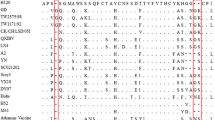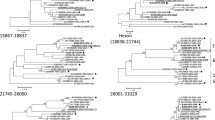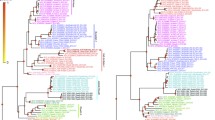Abstract
This study reports the complete genome sequence of an infectious bronchitis virus (CK/CH/SD/121220, KJ128295) isolated in 2012 from Shandong Province in northern China. The genome is 27,666 nt long, comprising six genes and 5′ and 3′ untranslated regions. The full-length genome of the CK/CH/SD/121220 isolate had the highest nucleotide sequence identity (96.7 %) to the YX10 strain. Sites of recombination were identified in the genes 1ab, S, 5a, 5b and N, with their putative parental strains belonging to the QX- and YN-type subgroups, which are already circulating in China. Our findings suggest an important role played by recombination in IBV evolution.
Similar content being viewed by others
Infectious bronchitis virus (IBV) is a member of the genus Gammacoronavirus within the family Coronaviridae [4]. It is an important viral pathogen affecting chickens of all ages. The IBV virion is enveloped, and it genome is a positive-sense, non-segmented, single-stranded RNA molecule of approximately 27.6 kb [16]. Gene 1 comprises approximately two-thirds of the genome and encodes two overlapping open reading frames (ORFs), 1a and 1b, which are translated as the large polyprotein 1ab. Protein 1ab can be divided into 15 or 16 nonstructural proteins (nsp) and is associated with RNA replication and transcription. The remaining one-third of the genome encodes the four main structural proteins: the spike (S) glycoprotein and the envelope (E), membrane (M), and nucleocapsid (N) proteins. There are also two accessory genes interspersed amongst the structural protein genes, genes 3 and 5, which encode the small non-structural proteins 3a, 3b, 5a, and 5b [7, 14]. IBV is a coronavirus with a single-stranded RNA genome, and it has high genetic variability through spontaneous mutations and genetic recombination [5]. The viral genome is prone to point mutations, insertions, deletions or recombination, resulting in the appearance of a large number of IBV variants, which confer little or no cross-protection against each other [15].
An IBV variant identified in China was the QX variant, a significant IBV type that has been circulating in China for a long period of time. The QX variant was first reported in China in 1998 [28] and spread quickly across Russia [3] and many European countries, including the Netherlands, Germany, France, Belgium, England, and Spain [1, 2, 24, 25]. These strains evolved to form a new subgroup of QX isolates. According to reports regarding clinical cases worldwide, there is little doubt that QX variants of IBV have caused severe losses to both the layer and broiler segments of the poultry industry. This has posed major problems for the control of avian infectious bronchitis (IB) globally.
Recombination events often tend to occur during IBV replication and evolution [6, 10, 13, 26]. There is some evidence that vaccine strains might play an important role in the generation of IBV variants in the field [10]. If a cell is infected by two IBV strains, it is possible that the progeny virus might have sequence(s) derived from both parental strains [5]. Sequencing of many field strains has provided convincing evidence that a large number of IBV strains are recombinants between different IBV strains [6, 12]. Although chicken flocks in most geographical locations have been routinely vaccinated with live vaccines, outbreaks of IB have been observed in vaccinated flocks. This is possibly due to infection by different serotypes and the emergence of IBV antigenic variants.
In August 2012, 28-day-old broiler chicks from a flock in Shandong province of China that had been vaccinated oculonasally with IBV H120 vaccine on days 1, and 10, exhibited classical IB signs characterized by decreased feed intake, aggravating respiratory symptoms, and severe renal disease causing high morbidity. An IBV strain (CK/CH/SD/121220) was isolated from the kidney tissues of the dead chicks. To investigate the characteristics and potential genetic origin of this strain, we sequenced its genome and conducted sequence comparisons along with phylogenetic and recombination analysis to determine any relationships between CK/CH/SD/121220 and other IBVs.
Twenty-five primer pairs were designed based on the complete published sequences of the IBV genome using Primer Premier software version 5.0 to amplify the complete genome (excluding the 5′- and 3′-terminal segments) of the CK/CH/SD/121220 strain (The primer sequences are not shown). Viral RNA was extracted from virus-infected allantoic fluid using TRIzol Reagent (Invitrogen, Carlsbad, CA, USA) according to the manufacturer’s instructions. Reverse transcription was conducted at 37 °C for 1 h, with 3 μg of total RNA, 1 μl of random hexamer primers (500 μg/ml; Promega, Madison, WI, USA) and 0.5 μl of M-MLV reverse transcriptase (200 U/μl; Promega). For polymerase chain reaction (PCR) assays, 1 U of Taq DNA polymerase (Promega) and 10 pmol of each primer were added to 100 ng of template cDNA in a total reaction volume of 20 μl. Thermal cycling was performed at 95 °C for 5 min, followed by 30 cycles of denaturation (95 °C for 45 s), annealing (49 °C to 59 °C for 45 s, depending on the specific PCR reaction), and extension (72 °C for 2 min), and a final extension step at 72 °C for 10 min. We analyzed amplicons using 1.0 % (w/v) agarose gel electrophoresis, with amplicons of the predicted size isolated from gels and purified using an AxyPrep DNA Gel Extraction Kit (AxyGEN, Union City, CA, USA). Purified amplicons were inserted into the pMD18-T vector (Promega). Recombinant plasmids were extracted from positive clones using an E.Z.N.A.R. Plasmid Miniprep Kit (Omega, Norcross, GA, USA) and identified by digestion with EcoRI (Promega). Nucleotide sequencing reactions were carried out by Sunbio Biotech (Beijing, China).
The nucleotide sequences of the CK/CH/SD/121220 strain were submitted to GenBank under accession no. KJ128295. The genome was 27,666 nt long, comprising six genes between the 5′ and 3′ untranslated regions (UTRs). We identified a 5′-Pol-S-3a-3b-E-M-5a-5b-N-UTR-3′ genome organization that is typical of avian IBV. The spike (S) protein gene of IBV CK/CH/SD/121220 was 3,471 nt long (1,156 amino acids), and the cleavage site on the spike protein was HRRRR, consistent with most Chinese IBV isolates [11].
The complete coding sequence of the IBV CK/CH/SD/121220 isolate was aligned and analyzed using the ClustalW multiple alignment algorithm in the MegAlign program of the DNASTAR software suite version 3.1 (DNASTAR, Madison, WI, USA). Sequences of full-length genomes and structural genes were compared using MEGA5.0 software (www.megasoftware.net) and the Kimura 2-parameter nucleotide substitution model. Comparison of full-length genome sequences revealed that the CK/CH/SD/121220 strain had the highest nucleotide sequence identity (96.7 %) to the recombinant YX10 strain (GenBank accession no. JX840411) isolated from southern China. In the S1 gene, the nucleotide and amino acid (aa) sequence similarities among CK/CH/SD/121220 and other strains were between 59.9-94.9 % and 48.2-95.1 %, respectively. The isolate showed the highest homology to the LX4 strain (94.9 % nt and 94.7 % aa sequence identity), while the homology to the H120 strain did not exceed 76 %. There was one proline insertion between positions 22 and 24 in the deduced aa sequence when compared with the H120 strain. The same aa insert was only found in the LX4 S1 gene among the 48 reference strains. The nt and aa sequence identity among coding regions of S2, gene 3, M, gene 5, and the N protein gene of CK/CH/SD/121220 and other strain was 69.8–100 % and 56.1-99.6 %, respectively. Strain CK/CH/SD/121220 differed considerably in gene 5 compared with the other genes, which may indicate the occurrence of recombination events. Phylogenetic analysis based on the full-length genome, S1, S2, E, M, and N gene sequences suggested that the CK/CH/SD/121220 isolate had a close phylogenetic relationship to the QX-type IBV isolates YX10, sczy3 and CK/CH/LZJ/111113 recently isolated from diseased flocks in China (Fig. 1A-F).
Phylogenetic trees of avian infectious bronchitis virus (IBV) strains constructed to determine the evolutionary history of the complete genome (A), S1 gene (B), S2 gene (C), E gene (D), M gene (E), and N gene (F). The neighbor-joining method was used with 1,000 bootstrap replicates. A black dot (•) indicates an isolate newly sequenced in this study
The likelihood of recombination was statistically determined using SplitsTree version 4 (Simmonics, University of Warwick, Coventry, UK) [9] and Neighbor-Net analysis for evidence of networked relationships. Sequences were analyzed for recombination events using the Recombination Detection Program version 4.0 (RDP4; Simmonics, University of Warwick, Coventry, UK) [19]. The putative breakpoints and endpoints were determined as described previously [21]. Unless otherwise stated, default settings were used for all programs. The specific algorithms used were Rdp [17], Genecone [23], Bootscan [18], Maxchi [22], Chimaera [27], Siscan [19] and 3 Seq [20]. More than one method was used to analyze the data because results from only a single method were not reliable and could have resulted in misleading results. To eliminate interference from known recombinant isolates, we excluded recombinant isolates identified in other studies [8].
We used Neighbor-Net analysis to determine if there were networked relationships, as represented by boxes indicating probable sites of recombination among the analyzed sequences. Our results show that the largest number of boxes was found in the branch to which the isolate CK/CH/SD/121220 belonged, suggesting a strong possibility that recombination had occurred, especially in the S gene.
We also used RDP4 to identify recombination breakpoint positions in the CK/CH/SD/121220 genome (Table 1) and determined the most likely recombinant fragments (p ≤ 1 × 10−12), along with the possible parental virus and beginning and end points. The recombinant hotspots were mainly concentrated in the 1ab, Spike, 5a, 5b and N genes (Table 1), which have been reported to have higher mutation rates and more recombination events than other IBV genes. The major parent of CK/CH/SD/121220 was a QX-type IBV, while the minor parent was an YN-type IBV.
Recombination between IBVs and its role in emergence of new IBV variants has been reported previously and might occur at multiple sites [26]. Using network analysis, we determined that the cluster to which CK/CH/SD/121220 belongs is most likely to have undergone recombination. Recombinant strains with published sequences mainly belong to this phylogenetic branch. It was further demonstrated that the CK/CH/SD/121220 strain had undergone potential recombination events in six areas of the genome, including the nsp2–5, S1, S2, 5a, 5b and N genes. The start of the 1ab gene exhibited a high frequency of recombination events. Other genes also showed recombination between the QX- and YN-type IBVs, indicating that genomic RNA recombination of IBV might involve more than two strains and could occur in multiple genes during a natural infection. We hypothesize that CK/CH/SD/121220 is a chimeric strain derived from QX- and YN-type IBVs that evolved independently through point mutations and recombination events.
In summary, these analyses provide convincing evidence that recombination has occurred between IBVs currently circulating around the world. This has lead to the emergence of variant IBVs in China. The sequence of CK/CH/SD/121220 differs considerably from those of other IBVs and is most similar to those of QX-type IBVs. Phylogenic and recombination analyses indicated that CK/CH/SD/121220 is possibly a chimeric strain between the QX- and YN-like strains. Natural outbreaks of IBV are often the result of infections with strains that differ serologically from vaccine strains. To select optimal vaccine strains, the characterization of all prevalent strains must be conducted.
References
Abro SH, Renström LH, Ullman K, Isaksson M, Zohari S, Jansson DS, Belák S, Baule C (2012) Emergence of novel strains of avian infectious bronchitis virus in Sweden. Vet Microbiol 155:237–246
Abro SH, Renstrom LH, Ullman K, Belak S, Baule C (2012) Characterization and analysis of the full-length genome of a strain of the European QX-like genotype of infectious bronchitis virus. Arch Virol 157:1211–1215
Bochkov YA, Batchenko GV, Shcherbakova LO, Borisov AV, Drygin VV (2006) Molecular epizootiology of avian infectious bronchitis in Russia. Avian Pathol 35:379–393
Carstens E (2010) Ratification vote on taxonomic proposals to the International Committee on Taxonomy of Viruses (2009). Arch Virol 155:133–146
Cavanagh D (2007) Coronavirus avian infectious bronchitis virus. Vet Res 38:281–297
Cavanagh D, Davis P, Cook J (1992) Infectious bronchitis virus: evidence for recombination within the Massachusetts serotype. Avian Pathol 21:401–408
Cook JK, Jackwood M, Jones RC (2012) The long view: 40 years of infectious bronchitis research. Avian Pathol 41:239–250
He K, Li M, Wei P, Mo ML, Wei TC, Li KR (2012) Complete genome sequence of an infectious bronchitis virus chimera between cocirculating heterotypic strains. J Virol 86:13887–13888
Huson DH (1998) SplitsTree: analyzing and visualizing evolutionary data. Bioinformatics 14:68–73
Jia W, Karaca K, Parrish C, Naqi S (1995) A novel variant of avian infectious bronchitis virus resulting from recombination among three different strains. Arch Virol 140:259–271
Ji J, Xie J, Chen F, Shu D, Zuo K, Xue C, Qin J, Li H, Bi Y, Ma J (2011) Phylogenetic distribution and predominant genotype of the avian infectious bronchitis virus in China during 2008–2009. Virol J 8:184
Kottier SA, Cavanagh D, Britton P (1995) Experimental evidence of recombination in coronavirus infectious bronchitis virus. Virology 213:569–580
Kusters J, Jager E, Niesters H, Van Der Zeijst B (1990) Sequence evidence for RNA recombination in field isolates of avian coronavirus infectious bronchitis virus. Vaccine 8:605–608
Lai M, Cavanagh D (1997) The molecular biology of coronaviruses. Adv Virus Res 48:1–100
Lim TH, Lee HJ, Lee DH, Lee YN, Park JK, Youn HN, Kim MS, Lee JB, Park SY, Choi IS, Song CS (2011) An emerging recombinant cluster of nephropathogenic strains of avian infectious bronchitis virus in Korea. Infect Genet Evol 11:678–685
Liu XL, Su JL, Zhao JX, Zhang GZ (2009) Complete genome sequence analysis of a predominant infectious bronchitis virus (IBV) strain in China. Virus genes 38:56–65
Maidak BL, Olsen GJ, Larsen N, Overbeek R, McCaughey MJ, Woese CR (1997) The RDP (ribosomal database project). Nucleic Acids Res 25:109–110
Martin D, Posada D, Crandall K, Williamson C (2005) A modified bootscan algorithm for automated identification of recombinant sequences and recombination breakpoints. AIDS Res Hum Retrov 21:98–102
Martin D, Rybicki E (2000) RDP: detection of recombination amongst aligned sequences. Bioinformatics 16:562–563
Martin DP, Lemey P, Lott M, Moulton V, Posada D, Lefeuvre P (2010) RDP3: a flexible and fast computer program for analyzing recombination. Bioinformatics 26:2462–2463
Pond SLK, Posada D, Gravenor MB, Woelk CH, Frost SD (2006) GARD: a genetic algorithm for recombination detection. Bioinformatics 22:3096–3098
Posada D (2002) Evaluation of methods for detecting recombination from DNA sequences: empirical data. Mol Biol Evol 19:708–717
Sawyer S (1999) GENECONV: A computer package for the statistical detection of gene conversion. Distributed by the author, Department of Mathematics, Washington University in St, Louis
Sigrist B, Tobler K, Schybli M, Konrad L, Stöckli R, Cattoli G, Lüschow D, Hafez HM, Britton P, Hoop RK (2012) Detection of Avian coronavirus infectious bronchitis virus type QX infection in Switzerland. J Vet Diagn Invest 24:1180–1183
Valastro V, Monne I, Fasolato M, Cecchettin K, Parker D, Terregino C, Cattoli G (2010) QX-type infectious bronchitis virus in commercial flocks in the UK. Vet Rec 167:865
Wang L, Junker D, Collisson EW (1993) Evidence of natural recombination within the S1 gens of infectious bronchitis virus. Virology 192:710–716
Ye ZA, Moshovos A, Hauck S, Banerjee P (2000) CHIMAERA: a high-performance architecture with a tightly-coupled reconfigurable functional unit, ACM SIGARCH Computer Architecture News. ACM, New York, pp 225–235
Yu L, Jiang Y, Low S, Wang Z, Nam SJ, Liu W, Kwang J (2001) Characterization of three infectious bronchitis virus isolates from China associated with proventriculus in vaccinated chickens. Avian Dis 45:416–424
Acknowledgments
This study was supported by the China Agriculture Research System Poultry-Related Science and Technology Innovation Team of Peking (CARS-PSTP).
Author information
Authors and Affiliations
Corresponding author
Rights and permissions
About this article
Cite this article
Zhao, Y., Liu, Xy., Cheng, Jl. et al. Molecular characterization of an infectious bronchitis virus strain isolated from northern China in 2012. Arch Virol 159, 3457–3461 (2014). https://doi.org/10.1007/s00705-014-2213-1
Received:
Accepted:
Published:
Issue Date:
DOI: https://doi.org/10.1007/s00705-014-2213-1





